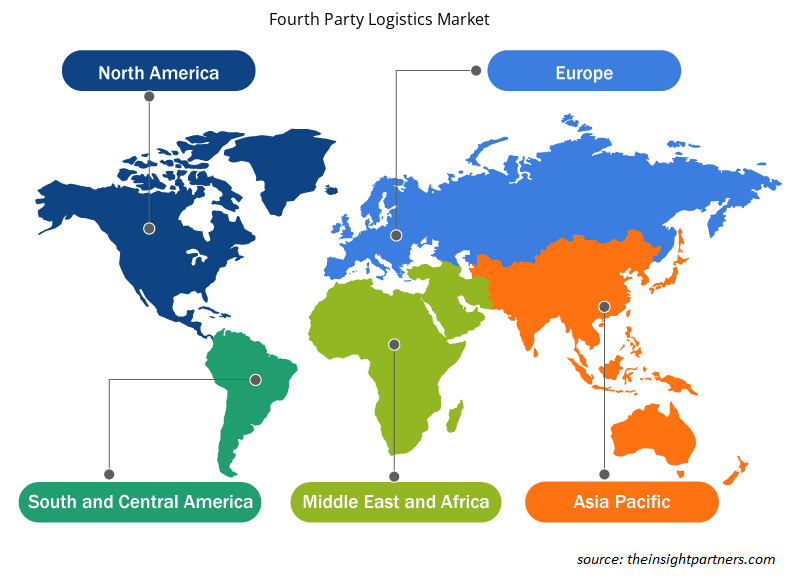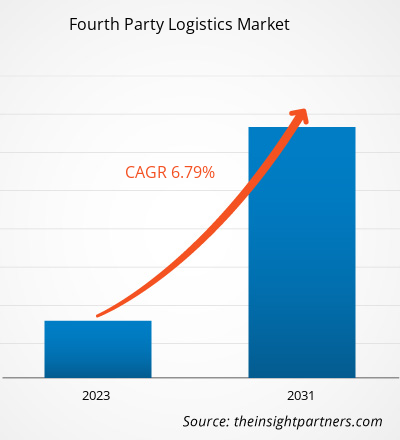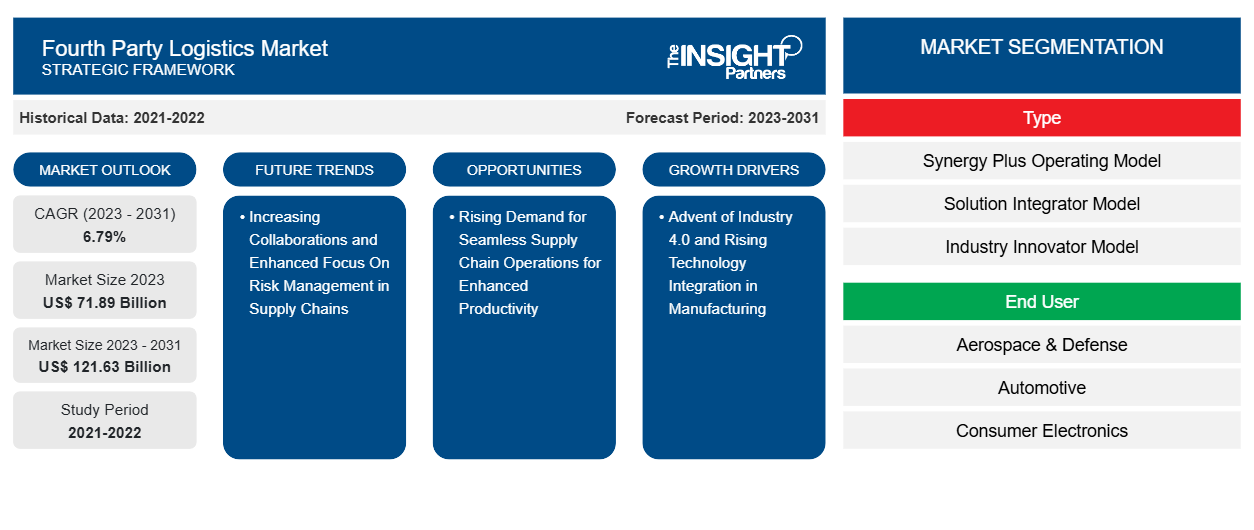Der Markt für Fourth-Party-Logistik soll von 71,89 Milliarden US-Dollar im Jahr 2023 auf 121,63 Milliarden US-Dollar im Jahr 2031 anwachsen. Für den Markt wird für den Zeitraum 2023–2031 eine durchschnittliche jährliche Wachstumsrate (CAGR) von 6,79 % erwartet.
Das Aufkommen von Industrie 4.0 hat zu einer digitalen Transformation des Fertigungssektors geführt. Verschiedene Akteure nutzen die Leistungsfähigkeit dieser hochentwickelten digitalen Technologien und verschaffen ihren Kunden durch die Rationalisierung verschiedener Lieferkettenprozesse einen Wettbewerbsvorteil.
Marktanalyse für Fourth Party Logistics
Es wurde beobachtet, dass die regionale Demografie auch eine wichtige Rolle beim Wachstum des 4PL-Dienstleistungsmarktes gespielt hat. Beispielsweise wird die Einführung von 4PL im Einzelhandelssektor beobachtet, der wiederum durch das Aufkommen des E-Commerce gestärkt wurde. Die Marktattraktivität der E-Commerce-Branche ist in der Region sehr hoch, da die Region APAC mehr als ein Drittel der Weltbevölkerung umfasst. Darüber hinaus haben sich entwickelnde Volkswirtschaften und steigende verfügbare Einkommen der Einzelpersonen das Wachstum der E-Commerce-Branche weiter vorangetrieben.
Zunehmende Nachfragevielfalt aufgrund der vielfältigen demografischen Entwicklung in der Region, die zur Komplexität der Lieferkette beiträgt. Diese komplexe Lieferkette trug zu einem wachsenden Bedarf der Reedereien an 4PL-Diensten bei. Seit dem letzten Jahrzehnt hat sich die Nachfrage in verschiedenen Endverbraucherbranchen mit der zunehmenden Einführung digitaler Technologien und weiterer technologischer Verbesserungen deutlich beschleunigt. Da die führenden Akteure in diesem Markt ihren Zielmarkt weiter ausbauen, indem sie ihre aktuellen Produktportfolios erweitern, ihre Kundenbasis diversifizieren und neue Anwendungen und Märkte entwickeln, sind alle führenden Akteure einem intensiven Wettbewerbsdruck ausgesetzt.
Marktübersicht für Viertanbieterlogistik
Durch das Outsourcing der gesamten Lieferkettenfunktionalität an einen erfahreneren Partner im Bereich Lieferkettenmanagement wird die Komplexität der Zustellung auf der letzten Meile verringert. Zu den immateriellen Vorteilen, die durch das Outsourcing der Logistik erzielt werden, gehören Kosteneinsparungen, Einsparungen beim Personal, keine Bindung von Betriebskapital und ein besserer Zugang zu Kundennetzwerken.
Das Aufkommen des Konzepts der Fourth-Party-Logistics war im Wesentlichen ein Schritt zur Beseitigung aller oben genannten Engpässe in der zunehmend komplexen Lieferkettenumgebung. Fourth-Party-Logistics (4PL)-Dienste werden auch als Supply-Chain-as-a-Service bezeichnet, bei denen sich der 4PL-Anbieter in die Logistikabteilung des Kundenunternehmens integriert. Dies ermöglicht dem 4PL-Dienstleister einen praktischen Ansatz für alle Abläufe in einer Lieferkette, von der Auftragsverwaltung über die Lagerhaltung und Compliance-Vorschriften bis hin zum Lieferantenmanagement. Ein 4PL-Dienstleister fungiert als einziges Bindeglied zwischen den zahlreichen Lieferkettenanbietern und der Kundenorganisation. Dabei verwaltet der 4PL-Anbieter alle Abläufe mit ausgefeilten Ressourcen, um den Kunden einen Mehrwert zu bieten und sie zu optimieren.
Passen Sie diesen Bericht Ihren Anforderungen an
Sie erhalten kostenlos individuelle Anpassungen an jedem Bericht, einschließlich Teilen dieses Berichts oder einer Analyse auf Länderebene, eines Excel-Datenpakets sowie tolle Angebote und Rabatte für Start-ups und Universitäten.
-
Holen Sie sich die wichtigsten Markttrends aus diesem Bericht.Dieses KOSTENLOSE Beispiel umfasst eine Datenanalyse von Markttrends bis hin zu Schätzungen und Prognosen.
Treiber und Chancen auf dem Fourth-Party-Logistics-Markt
Aufkommen von Industrie 4.0 und zunehmende Technologieintegration in der Fertigung
Neue digitale Technologien wie fortschrittliche Software , Cloud Computing und Big Data könnten von 4PL-Dienstleistern mit großem Erfolg eingesetzt werden, um die Sichtbarkeit über die gesamte Lieferkette hinweg aufrechtzuerhalten und so Sichtbarkeit, Transparenz, Abläufe und Produktivität zu verbessern. Da Technologien wie das Internet der Dinge (IoT), Automatisierung und Robotik immer wichtiger werden, wird der Bedarf der Unternehmen an der Bereitstellung von 4PL voraussichtlich schnell steigen.
Steigende Nachfrage nach nahtlosen Lieferkettenabläufen zur Steigerung der Produktivität
In einer Lieferkette sind die beweglichen Teile manchmal unvorhersehbaren Umständen wie Naturkatastrophen, geopolitischen Spannungen, Umweltproblemen, zollbedingten Komplikationen und Vorschriften sowie Schwankungen bei der Einhaltung von Vorschriften ausgesetzt. Darüber hinaus führt die fragmentierte Natur der Lieferketten zu einem Mangel an Kommunikation und Transparenz zwischen den beteiligten Einheiten. Die aktuellen Anforderungen der Verbraucher sind hochdynamisch, und selbst eine kleine Unzufriedenheit auf der Verbraucherseite kann große Auswirkungen auf die Gewinne des Unternehmens haben. Der kometenhafte Aufstieg der On-Demand-Lieferung von Produkten hat die heutigen Unternehmen dazu veranlasst, von den herkömmlichen internen Logistikmodellen zu einem fortschrittlicheren und kostengünstigeren ausgelagerten oder vertragsbasierten Logistikmodell überzugehen.
Segmentierungsanalyse des Marktberichts zur Viertanbieterlogistik
Schlüsselsegmente, die zur Ableitung der Marktanalyse für Fourth-Party-Logistik beigetragen haben, sind Typ und Endbenutzer.
- Basierend auf dem Typ wurde der Markt in Synergie-Plus-Betriebsmodell, Lösungsintegratormodell und Brancheninnovatormodell unterteilt. Das Segment der Lösungsintegratormodelle hatte im Jahr 2023 einen größeren Marktanteil.
- Basierend auf dem Endverbraucher ist der Markt in Luft- und Raumfahrt und Verteidigung, Automobil, Unterhaltungselektronik, Lebensmittel und Getränke, Industrie, Gesundheitswesen, Einzelhandel und andere unterteilt. Das Einzelhandelssegment hielt im Jahr 2023 den größten Marktanteil.
Marktanalyse für Fourth Party Logistics nach Geografie
Der geografische Umfang des Marktberichts zur Fourth-Party-Logistik ist hauptsächlich in fünf Regionen unterteilt: Nordamerika, Europa, Asien-Pazifik, Naher Osten und Afrika sowie Südamerika.
Der Umfang des Marktberichts zum Fourth-Party-Logistics-Markt umfasst Nordamerika (USA, Kanada und Mexiko), Europa (Spanien, Großbritannien, Deutschland, Frankreich, Italien und den Rest Europas), den asiatisch-pazifischen Raum (Südkorea, China, Indien, Japan, Australien und den Rest des asiatisch-pazifischen Raums), den Nahen Osten und Afrika (Südafrika, Saudi-Arabien, die Vereinigten Arabischen Emirate und den Rest des Nahen Ostens und Afrikas) sowie Süd- und Mittelamerika (Brasilien, Argentinien und den Rest Süd- und Mittelamerikas). In Bezug auf den Umsatz dominierte APAC den Marktanteil im Fourth-Party-Logistics-Markt im Jahr 2023. Europa ist der zweitgrößte Beitragszahler zum globalen Fourth-Party-Logistics-Markt, gefolgt von Nordamerika.
Die wirtschaftlich prosperierende Region Nordamerika besteht aus den hochentwickelten Volkswirtschaften der USA und Kanadas. Die Industrialisierung hat in den hochentwickelten Volkswirtschaften der USA und Kanadas nach wie vor eine hohe Priorität und war im Laufe der Jahre auch der Hauptfaktor, der die Wirtschaft ankurbelte. Die USA sollen die technologisch fortschrittlichsten Branchen der Welt in den Bereichen Automobil, Gesundheitswesen, Luft- und Raumfahrt und Verteidigung sowie Unterhaltungselektronik aufweisen. Die Massenproduktion und der damit verbundene Handel mit anderen Nationen der Welt machen die nordamerikanische Region zu einem strategischen Zentrum für Transport- und Logistikdienstleistungen. Da die Unternehmen in Nordamerika wirtschaftlich fortgeschritten sind, verfügen sie über große Budgets für Transport- und Logistikaktivitäten und tragen daher zur Entwicklung des Marktes für Logistikdienstleistungen der vierten Partei bei. Das Vorhandensein einer etablierten digitalen Infrastruktur in Nordamerika betont die Erweiterung der Horizonte im Bereich der Logistikdienstleistungen noch weiter. Typ (Synergy Plus-Betriebsmodell, Lösungsintegratormodell und Brancheninnovatormodell); Endbenutzer (Luft- und Raumfahrt und Verteidigung, Automobil, Unterhaltungselektronik, Lebensmittel und Getränke, Industrie, Gesundheitswesen, Einzelhandel und andere)
Regionale Einblicke in den Fourth Party Logistics-Markt
Die regionalen Trends und Faktoren, die den Markt für Fourth Party Logistics im Prognosezeitraum beeinflussen, wurden von den Analysten von Insight Partners ausführlich erläutert. In diesem Abschnitt werden auch die Marktsegmente und die Geografie des Fourth Party Logistics in Nordamerika, Europa, im asiatisch-pazifischen Raum, im Nahen Osten und Afrika sowie in Süd- und Mittelamerika erörtert.

- Erhalten Sie regionale Daten zum Fourth Party Logistics-Markt
Umfang des Marktberichts zur Viertanbieterlogistik
| Berichtsattribut | Details |
|---|---|
| Marktgröße im Jahr 2023 | 71,89 Milliarden US-Dollar |
| Marktgröße bis 2031 | 121,63 Milliarden US-Dollar |
| Globale CAGR (2023 - 2031) | 6,79 % |
| Historische Daten | 2021-2022 |
| Prognosezeitraum | 2023–2031 |
| Abgedeckte Segmente |
Nach Typ
|
| Abgedeckte Regionen und Länder |
Nordamerika
|
| Marktführer und wichtige Unternehmensprofile |
|
Dichte der Marktteilnehmer im Bereich Fourth Party Logistics: Die Auswirkungen auf die Geschäftsdynamik verstehen
Der Markt für Fourth Party Logistics wächst rasant, angetrieben durch die steigende Nachfrage der Endnutzer aufgrund von Faktoren wie sich entwickelnden Verbraucherpräferenzen, technologischen Fortschritten und einem größeren Bewusstsein für die Vorteile des Produkts. Mit steigender Nachfrage erweitern Unternehmen ihr Angebot, entwickeln Innovationen, um die Bedürfnisse der Verbraucher zu erfüllen, und nutzen neue Trends, was das Marktwachstum weiter ankurbelt.
Die Marktteilnehmerdichte bezieht sich auf die Verteilung von Firmen oder Unternehmen, die in einem bestimmten Markt oder einer bestimmten Branche tätig sind. Sie gibt an, wie viele Wettbewerber (Marktteilnehmer) in einem bestimmten Marktraum im Verhältnis zu seiner Größe oder seinem gesamten Marktwert präsent sind.
Die wichtigsten auf dem Fourth-Party-Logistics-Markt tätigen Unternehmen sind:
- Allyn Internationale Dienstleistungen
- Einschl.
- United Parcel Service
- Einschl.
- GEFCO-Gruppe
Haftungsausschluss : Die oben aufgeführten Unternehmen sind nicht in einer bestimmten Reihenfolge aufgeführt.

- Überblick über die wichtigsten Akteure auf dem Fourth Party Logistics-Markt
Neuigkeiten und aktuelle Entwicklungen zum Fourth Party Logistics-Markt
Der Markt für Fourth-Party-Logistik wird durch die Erhebung qualitativer und quantitativer Daten nach Primär- und Sekundärforschung bewertet, die wichtige Unternehmensveröffentlichungen, Verbandsdaten und Datenbanken umfasst. Im Folgenden finden Sie eine Liste der Entwicklungen auf dem Markt für Fourth-Party-Logistik und Strategien:
- Im Dezember 2023 gab XPO (NYSE: XPO), ein führender Anbieter von LTL-Frachttransporten in Nordamerika, bekannt, dass das US-Konkursgericht für den Bezirk Delaware dem Angebot des Unternehmens zur Übernahme von 28 Servicecenter-Standorten, die zuvor von Yellow Corporation betrieben wurden, zugestimmt hat. XPO wird 26 Servicecenter kaufen und bestehende Mietverträge für die beiden anderen Standorte übernehmen. Die Transaktion soll bis Ende 2023 abgeschlossen sein. (Quelle: XPO, Pressemitteilung/Unternehmenswebsite/Newsletter)
Marktbericht zur Fourth Party Logistics: Abdeckung und Ergebnisse
Der Bericht „Größe und Prognose des Fourth-Party-Logistics-Marktes (2021–2031)“ bietet eine detaillierte Analyse des Marktes, die die folgenden Bereiche abdeckt:
- Marktgröße und Prognose auf globaler, regionaler und Länderebene für alle wichtigen Marktsegmente, die im Rahmen des Projekts abgedeckt sind
- Marktdynamik wie Treiber, Beschränkungen und wichtige Chancen
- Wichtige Zukunftstrends
- Detaillierte Porter's Five Forces Analyse
- Globale und regionale Marktanalyse mit wichtigen Markttrends, wichtigen Akteuren, Vorschriften und aktuellen Marktentwicklungen
- Branchenlandschaft und Wettbewerbsanalyse, einschließlich Marktkonzentration, Heatmap-Analyse, prominenten Akteuren und aktuellen Entwicklungen
- Detaillierte Firmenprofile mit SWOT-Analyse
- Historische Analyse (2 Jahre), Basisjahr, Prognose (7 Jahre) mit CAGR
- PEST- und SWOT-Analyse
- Marktgröße Wert/Volumen – Global, Regional, Land
- Branchen- und Wettbewerbslandschaft
- Excel-Datensatz
Aktuelle Berichte
Verwandte Berichte
Erfahrungsberichte
Grund zum Kauf
- Fundierte Entscheidungsfindung
- Marktdynamik verstehen
- Wettbewerbsanalyse
- Kundeneinblicke
- Marktprognosen
- Risikominimierung
- Strategische Planung
- Investitionsbegründung
- Identifizierung neuer Märkte
- Verbesserung von Marketingstrategien
- Steigerung der Betriebseffizienz
- Anpassung an regulatorische Trends























 Kostenlose Probe anfordern für - Markt für Viertanbieterlogistik
Kostenlose Probe anfordern für - Markt für Viertanbieterlogistik